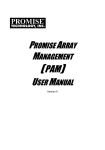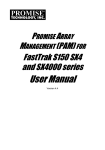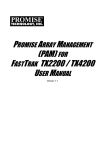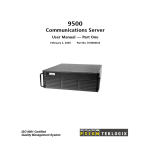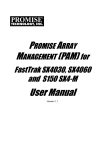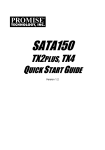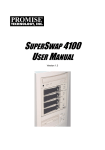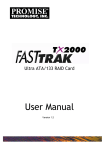Download (PAM) User Manual - Promise Technology, Inc.
Transcript
FastTrak TX4000, FastTrak S150 TX2plus, FastTrak S150 TX4 PROMISE ARRAY MANAGEMENT ( PAM) User Manual Version 1.1 Promise Array Management Copyright © 2003 Promise Technology, Inc. Copyright by Promise Technology, Inc. (Promise Technology). No part of this manual may be reproduced or transmitted in any form without the expressed, written permission of Promise Technology. Trademarks Promise, and the Promise logo are registered in U.S. Patent and Trademark Office. All other product names mentioned herein may be trademarks or registered trademarks of their respective companies. Important data protection information You should back up all data before installing any drive controller or storage peripheral. Promise Technology is not responsible for any loss of data resulting from the use, disuse or misuse of this or any other Promise Technology product. Notice Although Promise Technology has attempted to ensure the accuracy of the content of this manual, it is possible that this document may contain technical inaccuracies, typographical, or other errors. Promise Technology assumes no liability for any error in this publication, and for damages, whether direct, indirect, incidental, consequential or otherwise, that may result from such error, including, but not limited to loss of data or profits. Promise Technology provides this publication “as is” without warranty of any kind, either express or implied, including, but not limited to implied warranties of merchantability or fitness for a particular purpose. The published information in the manual is subject to change without notice. Promise Technology reserves the right to make changes in the product design, layout, and driver revisions without notification to its users. ii Contents Chapter 1: Introduction ............................................................................................... 1 PAM Components ............................................................................................... 1 How They Work Together ............................................................................ 2 PAM Installation Options ..................................................................................... 3 Chapter 2: Installation................................................................................................. 7 Installation Locations........................................................................................... 7 Monitoring Utility........................................................................................... 7 Message Server ........................................................................................... 9 Message Agent ............................................................................................ 9 Operating System Support .................................................................................. 9 Network Requirements...................................................................................... 10 Installation Procedure........................................................................................ 10 Chapter 3: Initial Setup ............................................................................................. 19 Local Agent Log-in ............................................................................................ 21 Remote Message Server Log-in........................................................................ 23 Create a New User............................................................................................ 24 Create an Array ................................................................................................. 25 Setup Email Alert Notification............................................................................ 29 Add a User to the Recipient List................................................................. 30 Specify Alert Notification Events........................................................................ 32 Chapter 4: PAM User Interface ................................................................................ 33 Tree View .......................................................................................................... 34 Tree View and Component Specific Menus ............................................... 35 Object View ....................................................................................................... 36 Information View................................................................................................ 37 Status Bar ......................................................................................................... 38 Pulldown Menus ................................................................................................ 38 Main ........................................................................................................... 38 View ........................................................................................................... 39 Connection ................................................................................................. 39 Preference.................................................................................................. 40 Help............................................................................................................ 41 Toolbar .............................................................................................................. 43 Popup Menus .................................................................................................... 45 MyConsole Icon ......................................................................................... 45 Remote Agent Icon .................................................................................... 45 Local Agent Icon ........................................................................................ 46 Device Icon ................................................................................................ 46 Controller Icon............................................................................................ 46 Channel Icon .............................................................................................. 46 Disk Icon .................................................................................................... 47 Array Icon................................................................................................... 47 Users Icon .................................................................................................. 47 User Icon.................................................................................................... 47 iii Promise Array Management Chapter 5: RAID Monitoring and Maintenance with PAM ......................................... 49 Remote Message Server Log-in........................................................................ 49 Remote Message Server................................................................................... 50 Create a New Remote Message Server..................................................... 50 Delete a Remote Message Server ............................................................. 52 Disconnect a Remote Message Server / Logout of RAID Server .............. 53 Reconnect a Remote Message Server ...................................................... 53 Remote Message Server Address Change................................................ 54 Local Agent Log-in ............................................................................................ 55 Manage Users ................................................................................................... 57 Create a New User..................................................................................... 57 Delete a User ............................................................................................. 58 Object Icons ............................................................................................... 58 Alert Notification ......................................................................................... 59 Add a User to the Recipient List................................................................. 60 Delete a User from the Recipient List......................................................... 61 Specify Alert Notification Events ................................................................ 62 Device ............................................................................................................... 63 Controller........................................................................................................... 64 View Event Log .......................................................................................... 64 Controller Options ...................................................................................... 65 Arrays................................................................................................................ 67 Create an Array.......................................................................................... 67 Synchronize an Array................................................................................. 71 Scheduled Synchronization................................................................. 71 On-Demand Synchronization .............................................................. 72 Rebuild an Array ........................................................................................ 73 Automatic Rebuild............................................................................... 74 Manual Rebuild ................................................................................... 75 Stop, Pause, Continue ........................................................................ 77 Object View ................................................................................................ 77 Delete Array ............................................................................................... 78 Array Status ............................................................................................... 78 Appendix .................................................................................................................. 79 RAID.................................................................................................................. 79 RAID 0 ....................................................................................................... 79 RAID 1 ....................................................................................................... 80 RAID 0+1 ................................................................................................... 80 IP Address......................................................................................................... 81 DHCP Issues..................................................................................................... 82 Technical Support ............................................................................................. 82 Technical Support Services........................................................................ 83 iv Chapter 1: Introduction Promise Array Management (PAM) is a utility application designed specifically for monitoring and managing Promise Technology RAID products, such as the FastTrak TX4000, FastTrak S150 TX2plus, and FastTrak S150 TX4. Promise includes BIOS-based RAID management utilities with each of its products. PAM, however, runs over a local area network and makes possible RAID monitoring and management from any computer on the network and even over Internet. This allows your IT manager to watch your RAIDs and take care of them over the network. PAM Components There are three components to PAM. Depending on your installation, all three may be on the same workstation or work separately across your network: Monitoring Utility ― The Monitoring Utility is a Graphic User Interface (GUI) that reports on the condition of the RAID array. It receives and displays reports on RAID condition and operation through the Message Server. The Monitoring Utility works on any PC with a TCP/IP network connection to your RAID. When installed on the computer that operates the RAID, the Monitoring Utility also provides a complete set of RAID management tools. Message Server ― The Message Server is the link connecting a PC with the Monitoring Utility. Normally, the Message Server runs on a network file server. But it can also run on the PC controlling the RAID. Message Agent ― The Message Agent runs on the PC that controls the RAID, called the “RAID PC”. It directly monitors the RAID and sends messages through the Message Server to all PCs running the Monitoring Utility. 1 Promise Array Management How They Work Together The Promise Array Management (PAM) utility provides and easy way to set up, monitor, modify and repair your RAID. PAM works with the Promise FastTrak TX4000, FastTrak S150 TX2plus, and FastTrak S150 TX4 RAID Controller cards. PAM watches the RAID and when significant events happen, or it discovers a problem, the Message Agent sends a warning to the Message Server. The Message Server passes the warning along to all PCs running the Monitoring Utility. Warnings appear on the PC in the form of email messages and popup alerts. You can select either one or both. You can also select which events and problems PAM will report. A major benefit of PAM is that it runs over a TCP/IP network. This enables remote monitoring of your RAIDs, including offsite monitoring over an Internet connection. Once you become aware of a problem, go to the PC that controls the RAID, called the “RAID PC” to take corrective action. If you have more than one RAID PC on your network, PAM will indicate which one has the problem. PAM allows only monitoring access through the network. Management access occurs only at the RAID PC. 2 Chapter 1: Introduction PAM Installation Options Following are some examples of ways you can incorporate PAM into your network and RAID systems. Modem Internet Home-based PC + Monitoring Utility Laptop computer + Monitoring Utility Router & Firewall Network File Server + Message Server A networked PC + Monitoring Utility Company LAN PC + FastTrak TX4000 + Message Agent PC + FastTrak S150 TX4 + Internal RAID array + Message Agent PC + FastTrak S150 TX2plus + Message Agent Figure 1-1. LAN and Internet connections. In the example on the facing page, there are three PCs with FastTrak cards connected to the company’s LAN. The PAM Message Agent runs on each of the PCs with a FastTrak card. The PAM Message Server runs on the company’s file server. The PAM Monitoring Utility runs on networked PCs and also on remote PCs connecting to the company network through the Internet. With this arrangement, you can monitor RAID condition and activity from offsite, such as a hotel room or home office. 3 Promise Array Management A networked PC + Monitoring Utility A networked PC + Monitoring Utility + Message Server Company LAN PC + FastTrak S150 TX2plus + Message Agent PC + FastTrak TX4000 + Internal RAID array + Message Agent PC + FastTrak S150 TX4 + Message Agent Figure 1-2. Company LAN without a File Server In the above example, there are three PCs with FastTrak cards connected to the company’s LAN, the same as before. But this network has no file server, so the PAM Message Server runs on one of the networked PCs. PAM Monitoring Utility runs on both networked PCs. If this LAN were upgraded with a suitable router and an Internet connection, you could set up offsite monitoring as in Figure 1-1. 4 Chapter 1: Introduction PC + FastTrak TX4000 + Monitoring Utility + Message Agent PC + FastTrak S150 TX4 + Internal RAID array + Monitoring Utility + Message Agent Figure 1-3. PCs with Internal RAID. Promise’s FastTrak card is designed to setup and control a RAID within the PC’s enclosure. They have the same need of monitoring and management as an external RAID subsystem. All three PAM components run on the PC itself. Important This manual accompanies a special version of PAM optimized to run with the FastTrak TX4000, FastTrak S150 TX2plus, and FastTrak S150 TX4. Other versions of PAM will run reliably on the Promise RAID product with which they ship. They will also run reliably on several Promise RAID products in normal use. However, they may not perform adequately with a FastTrak TX4000, FastTrak S150 TX2plus, or FastTrak S150 TX4. 5 Promise Array Management 6 Chapter 2: Installation To install Promise Array Management (PAM) is an uncomplicated procedure, once you understand your systems and how you want to use PAM. The purpose of this Chapter is to help you plan and carry out your installation of PAM. By way of review, PAM consists of three components: • Monitoring Utility • Message Server • Message Agent These were described in the previous chapter. Before proceeding with the installation, you must know which component goes where. If you plan to run PAM over a network, you must know the IP addresses of each computer on the network that will be involved in your RAID monitoring and management activity. Installation Locations In the table below, possible locations for each of the three PAM components. Monitoring Utility Message Server Internet-connected PC • Network PC • • Network File Server • • • • RAID PC Message Agent • Table 2-1. Acceptable PAM Component Installation Locations. Monitoring Utility The Monitoring Utility installs on any computer you will use to monitor and manage the RAIDs. If your RAID runs without a network connection, install it on the RAID PC with the rest of the PAM components. If your RAIDs are networked, you can install the Monitoring Utility on any computer connected to the network. 7 Promise Array Management If your company has networked RAIDs and Internet access, you may choose to install the Monitoring Utility on a laptop or home-based PC for dial-in remote access. Limit your installation to the computers of RAID users and your IT administrator. PAM features password protection to further limit access and provide security of your data. Modem Internet Home-based PC + Monitoring Utility Laptop computer + Monitoring Utility Router & Firewall Network File Server + Message Server A networked PC + Monitoring Utility Company LAN PC + FastTrak TX4000 + Message Agent PC + FastTrak S150 TX4 + Internal RAID array + Message Agent PC + FastTrak S150 TX2plus + Message Agent Figure 2-1. Networked RAID has many installation options. 8 Chapter 2: Installation Message Server The Message Server is required if your RAID PC connects to a network. If you want run PAM over a network, install the Message Server on one of your networked computers including a file server, a networked PC or the RAID PC. Only one installation of the Message Server is required for PAM to work over a network. You may install Message Server on more than one network PC or file server, but PAM’s network configuration will only use one of them, thus any additional installations are useless. Do not install the Message Server on any PC that may be disconnected from the network, such as a laptop or a computer that connects via the Internet. Not only will a disconnect cause PAM to fail, but reconnecting again may involve time-consuming network configuration. Network configuration is discussed later in this chapter. Message Agent The Message Agent installs on the RAID PC, whether your RAID is networked or not. In order for PAM to monitor and manage a RAID, it must have Message Agent installed. If you have more than one PAM-compatible RAID PC on your network, you may install a copy of Message Agent on all of them. Operating System Support PAM is a utility designed to run on top of previously installed Promise FastTrak card. Generally, if your PC runs the FastTrak card properly, it will run PAM also. Promise Technology recommends Windows NT 4.0, 2000 and XP Professional to take full advantage of all the features of PAM. In some cases, you can run PAM on other Windows operating systems. This becomes an issue when running PAM over a network where there are PCs with different operating systems. 9 Promise Array Management Network Requirements If you plan to install PAM on a network be sure all the hosts and servers are connected and running. That is, each of the PCs, RAIDs and Servers must have a working network connection before you install PAM. In order for PAM to be configured over a network, you must know the IP (network) address of the RAID PC(s) in your system. The Message Server uses IP addresses to communicate with the Message Agent on the RAID PCs and the Monitoring Utility on the network PCs. See the Appendix for help in finding the IP Address of the RAID PC. Installation Procedure Before you start… If you are installing PAM to run over a network, determine the computers and servers onto which you will install PAM. Obtain the IP addresses of all RAID PCs where PAM will be installed. PAM Installation With that information ready, follow these steps to install PAM on each computer or server: 1. Boot the PC/server and launch Windows. If the computer is already running, exit all programs. 2. Insert FastTrak CD into your CD-ROM drive. 3. Open the CD and locate the PAM folder. 4. Inside the PAM folder, look for the PAM Setup icon. See below. 5. Double-click the icon to run the installer. The opening screen appears. 10 Chapter 2: Installation Figure 2-2. PAM Setup Opening Screen. 6. In the Setup Opening Screen, select Customize from the dropdown menu and click Next. The Setup dialog box appears. Figure 2-3.The Setup dialog box. 7. In the Setup dialog box, choose your FastTrak card from the Select Hardware Type dropdown menu. If you have more than one type of FastTrak in your PC, select All. 11 Promise Array Management 8. In the Program Mode box, select the installation option appropriate for your system. RAID Server – Installs the Message Server on a file server or other networked computer. RAID Agent – Installs the Message Agent and FastTrak component(s) on the RAID PC. Use this option when you plan to monitor the RAID Array from another computer on the network. Remote Client – Installs the Monitoring Utility on a networked computer in order to monitor the RAID over the network. Local Client – Installs the Message Agent, Monitoring Utility and FastTrak component(s) on the RAID PC. Use this option when you plan to monitor the RAID Array from the RAID PC. Other – Enables manual selection of components. Use this option for special arrangements, such as installing a RAID Server with the other components on the RAID PC. When you have finished your selections, click Next or press Enter to continue. The Installation Summary Screen appears. Figure 2-4. Installation Summary Screen. 9. In the Installation Summary Screen, review your selections and click Finish to proceed with the installation. Click Back to make a change. 12 Chapter 2: Installation Figure 2-5. The License Agreement. 10. When the License Agreement appears, click the Yes button to agree to the terms and continue the installation. If you click No, PAM Setup will exit. Figure 2-6. Choose Destination dialog box. 11. When the Choose Destination dialog box appears, click the Browse button to specify a destination folder other than the default. When you are satisfied with the folder location, click Next or press Enter. 13 Promise Array Management Figure 2-7. Select Program Folder dialog box. 12. The Select Program Folder dialog box adds the PAM Remote Monitoring Utility in your Windows Start menu. When it appears, you may accept this folder name or change it. When you are satisfied with the folder name, click Next or press Enter. Figure 2-8. Start Copying Files dialog box. 13. When the Start Copying Files dialog box appears review the selection of application (Promise Array Management) and its destination. If you want 14 Chapter 2: Installation to make a change, click the Back button. Otherwise, click Next or press Enter to continue with the installation. Note If you are only installing the Message Server, this completes the installation. Figure 2-9. Install Message Server dialog box. 14. When the Install Message Server dialog box appears, type in the IP address of the RAID PC, that is, the PC with the FastTrak card. Click Next or press Enter to continue. 15 Promise Array Management Figure 2-10. Add User Account dialog box. 15. When the Add User Account dialog box appears, you may accept the default name or enter a new one in the Name field. Enter your password in the Password and Confirm Password fields. When you are done, click Next or press Enter to continue. Figure 2-11. The PAM Installation dialog box. 16. When the PAM Installation dialog box appears, the installation is complete. 16 Chapter 2: Installation Check one or both boxes to see the latest ReadMe file and launch PAM. When you are done, click Finish or press Enter. This completes the PAM installation. Go on to Chapter 3, Initial Setup. 17 Promise Array Management 18 Chapter 3: Initial Setup After you have completed installation, you must setup your PAM Monitoring Utility to work with your RAID. Figure 3-1. PAM in the Start Menu. In the Windows Start Menu, launch the PAM Monitoring Utility. The opening screen appears. If you are running PAM from the RAID PC, choose Local Monitoring Utility. If you are monitoring RAIDs on other PCs over a network, choose Remote Monitoring Utility. Note If you only installed the Message Server, this shortcut does not appear. The Message Server works only through network connections and has no user interface. Go to the RAID PC or a Networked PC to setup PAM. 19 Promise Array Management Object View Tree View Information View Figure 3-2. The PAM Monitor window has three views. The Monitor window is the user interface for PAM. It has three views: Tree View ― Displays the elements of your RAID system. It works like Windows Explorer with hierarchical menus. You can expand individual items to see their components. If you selected Remote Monitoring Utility, a different icon will appear in place of Local Agent in Tree View (right). Object View ― Displays icons representing the devices below the highlighted device in the Tree View. Information View ― Displays information on the item highlighted in the Tree View. This may include text boxes, list boxes, fields and buttons. It varies with the item selected. 20 Chapter 3: Initial Setup Local Agent Log-in The Message Server relays data and commands between the Monitoring Utility on this computer and the Message Agent on the RAID PC. Figure 3-3. Logging in to the Local Agent. 1. Right click on the Local Agent icon in Tree View. Select Login from the popup menu. See Figure 3-3. The Login dialog box appears. Figure 3-4. Login dialog box. 2. In the Login dialog box, type your Username and Password, and click OK. Initially, administrator is the only user. Use the administrator’s password selected during installation. 21 Promise Array Management Figure 3-5. Successful login. When login is successful, the Local Agent changes to the name of the RAID PC. See Figure 3-5. 22 Chapter 3: Initial Setup Remote Message Server Log-in The Message Server relays data and commands between the Monitoring Utility on this computer and the Message Agent on the RAID PC. Figure 3-5. Logging in to the Remote Agent. 1. Right click on a Remote Server icon in Tree View. Select Login from the popup menu. See Figure 3-3. The Login dialog box appears. Figure 3-6. Login dialog box. 2. In the Login dialog box, type your Username and Password, and click OK. 23 Promise Array Management Create a New User With the Message Agent accessed, you can add a new user. The Administrator is created by default. You must create additional users manually. 1. Right-click on the Users icon menu (right). A new user icon and select New > User from the popup appears. Figure 3-7. User Information View. 2. Click on the new user icon to display the User Information View. The User Information View displays a request for new user identification and access rights. Rights Definition Array Administration Create, delete and maintain arrays. View statistics Adapter Maintenance Modify cache and performance parameters of the RAID controller User Account Allows user to modify his/her own rights and to create and delete other users Only an administrator can create and delete arrays and view array statistics. 24 Chapter 3: Initial Setup 3. Type in a type in the Username and Password in their respective fields. Check all the appropriate boxes to set access rights. Click the Commit button when you are done. The new user’s name appears in the Tree View (right). Create an Array 1. In Tree View, click the + to the left of the to see the Channels. Controller icon 2. Click the + to the left of each Channel to see the disk drive. If there is no +, the Channel does not recognize a disk drive. In the example (right) there are three disk drives available to make an array. The available RAID selection depends on the number of disk drives available. The table below lists the options. See the Appendix for a more detailed description. RAID Level Name Minimum drives Maximum drives 0 Striping 1 4 1 Mirroring 2 2 0+1 Striping + Mirroring 4 4 Table 3-1. RAID Levels for FastTrak TX4000, S150 TX2plus and TX4. 25 Promise Array Management Caution This caution applies to FastTrak S150 TX2plus, which has a combination of Serial and Parallel ATA Channels. With some models of hard drives, if the Master hard drive fails, it may cause the Slave hard drive to be unrecognized by the computer's operating system. Where a RAID 1 (Mirroring) array exists on the Master/Slave pair, this condition may cause the operating system to freeze. Do NOT create a RAID 1 (Mirroring) array with two Parallel ATA hard drives using the Master/Slave arrangement on Channel 3 (the Parallel ATA port). You can create a RAID 1 (Mirroring) array by combining hard drives on: • Channels 1 and 2 (Serial ATA only) • Channels 1 and 3 (one Serial, one Parallel) • Channels 2 and 3 (one Serial, one Parallel) 3. Right-click on the Controller icon . Select New > Array from the popup menu (right). The Select Disk dialog box appears showing the available (unassigned) disk drives. Figure 3-8. Select Disk dialog box. 26 Chapter 3: Initial Setup 4. Click on a drive icon to select it. Hold down the Shift or Ctrl key for multiple selections. Click Next to continue. The Select RAID mode dialog box appears. Figure 3-9. Select RAID mode dialog box. 5. Click on an array icon to select it. Only the arrays that can be created from your selection of disk drives will display. Click Next to continue. The Finish Creation dialog box appears. Figure 3-10. The Finish Creation dialog box. 6. Type in an Array name. 27 Promise Array Management If this is a Striping (RAID 0) Array or a Striping+Mirroring (RAID 0+1) Array, select a Stripe Block Size from the dropdown menu. The default Block size is 64KB. Click Finish to continue. The following message appears, reminding you to reboot your PC in order to access your new Array. Figure 3-11. Array Created and Reboot messages. A new array icon appears in the Tree View (right). At this point, the new array is ready to be partitioned and formatted In Windows. 28 Chapter 3: Initial Setup Setup Email Alert Notification PAM alerts you to the problems and processes happening to your RAID through email and popup messages. These steps describe how to setup the email function. 1. Click on the Local Agent icon appears in Information View. . Information for the Local Agent Figure 3-12. Static portion of Information View. 2. Click on the Enable NT system event log, if it is not already checked. 3. If you want Anti-SPAM Protection, to block repeated error and event messages within a set period of time, click on this option and set an hour interval. Figure 3-13. Email Server portion of Information View. 4. Click on the Email alert on error box, if it is not already checked. 5. In the SMTP server field, type in the SMTP address for your mail server. 6. Select among Authentication Methods: • Cram MD5 • Authenticated Login • Plain Login • None 29 Promise Array Management 7. If you choose an Authentication Method, enter a Username and Password in the fields provided. 8. Click the Change button to update your configuration. Figure 3-14. Email Sender and Recipients. 9. Scroll down to the Email Sender and Recipients box. 10. In the Email ID of Alert Sender field, type in the email address of this computer. This address will appear in the From field of the email alerts. Recipients may reply to this address, if it is valid. 11. Click the Change button to update your configuration. Add a User to the Recipient List After you have setup email alert notification, you must specify who shall receive the alerts. 1. Click on the Message Agent icon to which you wish to add an email alert message recipient. 2. In the Alert Recipients Email Address List, type in the email address of the user who you wish to receive alerts. See Figure 3-14. 3. Click the Add button when you are done. The names appear in the Current Recipients window. 30 Chapter 3: Initial Setup Figure 3-15. Current Email Alert Recipients 4. Repeat Step 2 until all addresses have been added. 31 Promise Array Management Specify Alert Notification Events PAM can be configured to report a variety of alerts, by email, popup message or both. This section describes how to tell PAM what to report and which method to use. 1. Click on the Local Agent icon whose alert notification events you wish to modify. 2. In the Information View, scroll down to see the Add Events window. Figure 3-16. Specifying Events for Alert Notification. 3. From the left column, select an Event you want reported. 4. Right click on the Email column. Select Yes or No from the popup menu. 5. Right click on the Popup column. Select Yes or No from the popup menu. Selecting Yes adds that item to the Email or Popup list. Selecting No deletes the item. 6. When you are finished, click the Change button. 32 Chapter 4: PAM User Interface This chapter describes PAM’s Graphic User Interface (GUI). You should understand that PAM is software running on top of the Promise RAID BIOS and other applications that came with your Promise RAID product. PAM adds a graphic user interface to make RAID management functions easier to understand and perform. Object View Tree View Information View Figure 4-1. The PAM Monitor window has three views. 33 Promise Array Management Tree View The Monitor window is the user interface for PAM. It has three views: Tree View, Object View and Information View which were introduced in Chapter 3. The Tree View displays all of the elements of your RAID system. Use it to navigate to specific components. Figure 4-2. An example of a RAID system in Tree View. Normally, the Tree View is present. To close it, right-click on any object and select Hide Pane from the popup menu. To open it again, go to View menu and Outline. 34 Chapter 4: User Interface Tree View and Component Specific Menus In PAM, like most Windows applications, you can access the various commands and functions by opening dropdown menus and clicking on icons. Each time you click on a component in Tree View, PAM’s menu bar also displays that component’s dropdown menu. Below are some examples. Figure 4-3. Each item in Tree View has its own dropdown menu in the menu bar. Rather than access the menu bar, you can right click on the icon of the component you are working with. The menu bar and popup menus for Tree View items are identical. 35 Promise Array Management Object View Object View is visible whenever the Tree View is visible. The items appearing in Object View are determined by which component you select in Tree View. In the example below, we selected a Controller icon in Tree View. Figure 4-4. Object View of a Controller’s components. As a result, you see the components of that Controller, in this case, six channels, an enclosure and an array. This feature makes it easy to find an individual component as well as see what items are assigned to higher level components. Double-click on these items to see their components in Object View and their configuration in Information View. 36 Chapter 4: User Interface Information View Information View, like Object View, changes its content depending on which item you select in Tree View. The difference is that you use Information View to obtain data, input settings and information. Figure 4-5. Information View showing part of the setup for an Array. 37 Promise Array Management Status Bar The PAM Status Bar is the same as other Windows applications. It indicates such things as the selected RAID is rebuilding, and the current user is the Administrator (shown below). Figure 4-6. PAM Status Bar. Normally the Status Bar is visible. To show or hide the Status Bar, go to the View menu and check or uncheck Status Bar. Pulldown Menus As indicated above, the left-most item of the Pulldown Menus changes according to which component is selected in the Tree View. The Pulldown menu and popup (right-click) menus are the same. Main When no item in Tree View is selected, the left-most menu item is Main. Figure 4-7. Main Menu. Its only function is Exit, which quits the PAM application. 38 Chapter 4: User Interface View The View menu displays or hides three items: • • • Toolbar Status Bar Tree View (Outline) Figure 4-8. View Menu. Check to display or uncheck to hide each one as you prefer. Connection The Connection menu deals with server connections. Use it to: • • • Create a new Message Server Connect to a RAID Server Disconnect from a RAID server Figure 4-9.The Connection Menu. To create a new Message Server, click on the MyConsole icon select Connection > New Server. , then To connect a Message Server to a RAID server, click on the Message Server icon , the select Connection > Connect. To disconnect a Message Server from a RAID server, click on the Message Server icon , the select Connection > Disconnect. 39 Promise Array Management Preference The Preference menu allows you to: • • • Select the font PAM displays Select the background colors of the Views Have PAM run automatically when your PC boots Figure 4-10. The Preference Menu. Fonts and colors are a matter of individual preference. PAM will display any font properly loaded on your PC. PAM uses the Windows color palette, allowing you to select any color your monitor can display. If you are using PAM for remote monitoring, running PAM automatically is a good idea. This way, your PC will be connected to the RAID and you will receive all the alerts messages you have specified. 40 Chapter 4: User Interface Help Under Help, PAM has: • • • • Full online Help file Table of keyboard shortcuts Auto Demo display About page with PAM information Figure 4-11. Help Menu. PAM’s online help follows the standard three-panel interface with Contents, Index and Find. Figure 4-12. Online Help panels: (L to R) Contents, Index, Find. The table of keyboard shortcuts lists effort saving ways to perform certain functions. 41 Promise Array Management Figure 4-13. Keyboard shortcuts. The Auto Demo display provides a level-by-level display of each screen in the PAM interface. There are keyboard shortcuts for controlling the Auto Demo. The about page provides information about the PAM software. This information may be of use should you find the need to contact Promise Technical Support. 42 Chapter 4: User Interface Toolbar The Toolbar is a series of buttons that are shortcuts to performing specific tasks. You will never see all buttons active as in the example below. Figure 4-14. The Toolbar. They become active when you click on specific system components in Tree View. Only the tool buttons pertaining to that component are active. Most of these functions require User Account Rights. These are specified when a User is added or modified. Following is a description of the Toolbar buttons: New Server. Available when you select the MyConsole icon. Creates a new Message Server. Connect. Available when you select a Message Server icon. Initiates a connection with the RAID Server. Disconnect. Available when you select a Message Server icon. Disconnects from the RAID Server. Used when you want to shut down a RAID server for repair. Rebuild Array. Available when you select an Array icon for RAID level 1 or 0+1. Begins the process of restoring data after a drive was replaced. Synchronize Array. Available when you select an Array icon for RAID 1 or 0+1. Writes mirrored data to ensure both drives have identical data. Delete Array. Available when you select an Array icon. Deletes the array from the RAID system. Create Array. Available when you select a Message Agent icon. Allows you to create a new array on the RAID system. Delete User. Available when you select a User icon. Deletes a user from monitoring and alert access. New User. Available when you select the Users icon. Continue. Available when you have paused the rebuild of an Array. Resumes the rebuild process. 43 Promise Array Management Pause. Available when you are rebuilding an Array. Temporarily interrupts the rebuild process. Stop. Available when you are rebuilding an Array. Permanently halts the rebuild process. Help. Always available. Brings up the Online Help. 44 Chapter 4: User Interface Popup Menus In addition to the commands in the dropdown menus, there is a corresponding set of commands you can access via popup menus. In a popup menu, you can use any of the commands that are in black. You will notice that some functions are grayed out, meaning that you cannot use them. Many functions require that you have User Account Rights to perform them. All the menus have these three features, relating to Tree View but not the icon itself: • Refresh the screen display • Expand / Collapse the Tree • Hide Tree View MyConsole Icon Right-click on the MyConsole icon following commands (right): • Create a new Message Server • Rename MyConsole to access the This menu matches the MyConsole pulldown menu. Remote Agent Icon Right-click on the Message Server icon to access the following commands (right): • Modify this Message Server. See Information View • Delete this Message Server • Connect / Disconnect this Message Server from the Message Agent • Rename this Message Server This menu matches the Server pulldown menu. 45 Promise Array Management Local Agent Icon Right-click on the Message Agent icon to access the following commands (right): • Login to / Logout from this Message Agent • Rename this Message Agent This menu matches the RAIDMachine pulldown menu. Device Icon The Device icon represents the FastTrak PCI card (right). There are no commands for this item. This menu matches the RAIDSystem pulldown menu. Controller Icon Right-click on the Controller icon to access the following commands (right): • Create a new Array • Read controller events • Clear controller events • Toggle the Synchronize/Rebuild beeper on and off. Checked is ON. This menu matches the Controller pulldown menu. Channel Icon The Channel icon represents an individual channel on the FastTrak PCI card (right). There are no commands for this item. This menu matches the Channel pulldown menu. 46 Chapter 4: User Interface Disk Icon Right-click on the Disk icon of an unassigned drive to add it to a new array. of an If you right-click on the Disk icon assigned drive, this command will be grayed out. This menu matches the Disk pulldown menu. Array Icon Right-click on the Array icon to access the following commands (right): • Rebuild this array • Synchronize this array • Delete this array • Pause, Continue or Stop the Rebuild or Synchronize procedure This menu matches the Array pulldown menu. Users Icon Right-click on the Users icon account (right). to create a new User This menu matches the User Account pulldown menu. User Icon Right-click the User icon to delete or rename this user. This menu matches the User pulldown menu. 47 Promise Array Management 48 Chapter 5: RAID Monitoring and Maintenance with PAM This chapter describes using PAM to monitor and manage your RAID system. The chapter is divided into sections for major PAM components: • Remote Message Server • Local Agent • Controller • Channel • Enclosure • Array Remote Message Server Log-in The Message Server relays data and commands between the Monitoring Utility on this computer and the Message Agent on the RAID PC. Figure 5-1. Logging in to the Remote Agent. 49 Promise Array Management 1. Right click on a Remote Server icon in Tree View. Select Login from the popup menu. See Figure 5-1. The Login dialog box appears. Figure 5-2. Login dialog box. 2. In the Login dialog box, type your Username and Password, and click OK. Remote Message Server In order to perform the following procedures, you, as a user, must have Array Administration Rights. User rights are discussed in the Message Agent section of this chapter. Create a New Remote Message Server PAM has one Remote Message Server by default. If you want to create additional Servers, follow this procedure: 1. Click on the MyConsole icon in the Tree View. 2. Right-click and select New > Server from the popup menu (right). OR click the New Server button Toolbar. in the This action adds a new server RAIDSERVER1 icon (see Figure 5-3). 3. Click on the new server icon to select it. The Information window displays fields to add a Label and IP Address. 50 Chapter 5: RAID Monitoring and Maintenance Figure 5-3. The Remote Message Server’s Label and IP Address. Note: The IP Address shown above: 127.0.0.1, means that this computer is equipped with a FastTrak card. If you are performing this procedure on a networked PC, input the actual IP Address of the RAID PC in this field. See the Appendix for help in finding a PC’s IP address. 4. Click the Commit button. PAM connects the Message Server and connects over the network to the Local Agents on other RAID PCs (see Figure 5-4). 51 Promise Array Management Figure 5-4. The RAID PCs on the Network as seen in Object View. Delete a Remote Message Server If the Server’s IP address has changed, it will no longer function. You must delete the existing Server and create a new one with the current IP address. 1. Right click on the Message Server icon in Tree View. 2. Select Delete from the popup menu (right). 52 Chapter 5: RAID Monitoring and Maintenance Disconnect a Remote Message Server / Logout of RAID Server When you are about to perform maintenance or repair on a RAID server, use this procedure. This action will preserve your connection settings. PAM will still see the Message Server and show a disconnected status. Important This is the only correct way to log out a RAID Server from the system. To disconnect a Message Server, select it in Tree View then click the Disconnect button in the Toolbar, or: in Tree 1. Right click on the Message Server icon View. 2. Select Disconnect from the popup menu (right). Reconnect a Remote Message Server To reconnect a message Server you have taken offline, select it in Tree View then click on the Connect button in the Toolbar, or: 1. Right click on the Remote Message Server icon in Tree View. 2. Select Connect from the popup menu (right). 53 Promise Array Management Remote Message Server Address Change Occasionally, the IP address of a RAID server may change. This happens when the PC running Remote Message Server: • Is physically moved to a different location • Gets a new static IP address • The DHCP-assigned IP address was disconnected or shut down To make the address change, do the following: 1. Delete the existing Remote Message Server. 2. Create a new Remote Message Server. 54 Chapter 5: RAID Monitoring and Maintenance Local Agent Log-in The Message Server relays data and commands between the Monitoring Utility on this computer and the Message Agent on the RAID PC. Figure 5-5. Logging in to the Local Agent. 1. Right click on the Local Agent icon in Tree View. Select Login from the popup menu (Above). The Login dialog box appears. Figure 5-6. Login dialog box. 2. In the Login dialog box, type your Username and Password, and click OK. Initially, administrator is the only user. Use the administrator’s password selected during installation. 55 Promise Array Management Figure 5-7. Successful login. When login is successful, the Local Agent changes to the name of the RAID PC (Above). 56 Chapter 5: RAID Monitoring and Maintenance Manage Users Create a New User With the Message Agent accessed, you can add a new user. The Administrator is created by default. You must create additional users manually. 1. Right-click on the Users icon menu (right). A new user icon and select New > User from the popup appears. Figure 5-8. User Information View. 2. Click on the new user icon to display the User Information View. The User Information View displays a request for new user identification and access rights. User Rights Definition Array Administration Create, delete and maintain arrays. View statistics Adapter Maintenance Modify cache and performance parameters of the RAID controller User Account Allows user to modify his/her own rights and to create and delete other users Only an administrator can view array statistics. 57 Promise Array Management 3. Type in a type in the Username and Password in their respective fields. Check all the appropriate boxes to set access rights. Click the Commit button when you are done. The new user’s name appears in the Tree View (right). Delete a User 1. In the Tree View, right-click on the icon of the User you wish to delete and select Delete from the popup menu (right). 2. In the confirmation dialog box, click OK. Note: PAM will always keep one user account with access rights, typically the Administrator. This action protects you from being locked out of the system. Another way to delete a User: Select the User’s icon in Tree View then click the Delete User button in the Toolbar. Object Icons Select the Users icon Object View. in Tree View to see a display of individual Users in Figure 5-9. Users in Object View 58 Chapter 5: RAID Monitoring and Maintenance Alert Notification PAM alerts you to the problems and processes happening to your RAID through email and popup messages. These steps describe how to setup the email function. 1. Click on the Local Agent icon or Remote Message Server icon from which you wish to receive email alert messages. Figure 5-10. Static portion of Information View. 2. Click on the Enable NT system event log, if it is not already checked. 3. If you want Anti-SPAM Protection, to block repeated error and event messages within a set period of time, click on this option and set an hour interval. Figure 5-11. Email Server portion of Information View. 4. Click on the Email alert on error box in the Information View, if it is not already checked. 5. In the SMTP server field, type in the SMTP address for your mail server. 6. Click the Change button to update your configuration. 59 Promise Array Management Figure 5-12. Email Sender and Recipients. 7. Scroll down to the Email Sender and Recipients box. 8. In the Email ID of Alert Sender field, type in the email address of this computer. This address will appear in the From field of the email alerts. Recipients may reply to this address, if it is valid. 9. Click the Change button to update your configuration. Add a User to the Recipient List After you have setup email alert notification, you must specify who shall receive the alerts. 1. Click on the Message Agent icon to which you wish to add an email alert message recipient. 2. In the Alert Recipients Email Address List, type in the email address of the user who you wish to receive alerts (see below). 3. Click the Add button when you are done. The names appear in the Current Recipients window. Figure 5-13. Current Email Alert Recipients 4. Repeat Step 2 until all addresses have been added. 60 Chapter 5: RAID Monitoring and Maintenance Delete a User from the Recipient List To remove a recipient from the Email Address List, do the following: from which you wish to delete an 1. Click on the Message Agent icon email alert message recipient. The Current Recipients window appears in the Information View. See Figure 5-12. Figure 5-14. Select and remove a recipient. 2. Select the recipient you wish to delete 3. Click the Remove button or press Delete to remove the address from the list. 61 Promise Array Management Specify Alert Notification Events PAM can be configured to report a variety of alerts, by email, popup message or both. This section describes how to tell PAM what to report and which method to use. 1. Click on the Message Agent icon whose alert notification events you wish to modify. 2. In the Information View, scroll down to see the Add Events window. Figure 5-15. Specifying Events for Alert Notification. 3. From the left column, select an Event you want reported. 4. Right click on the Email column. Select Yes or No from the popup menu. 5. Right click on the Popup column. Select Yes or No from the popup menu. Selecting Yes adds that item to the Email or Popup list. Selecting No deletes the item. 6. When you are finished, click the Change button. 62 Chapter 5: RAID Monitoring and Maintenance Device The term Devices refers to a Promise RAID product: a FastTrak card. There are no control functions in PAM for Devices. But you can access information about them. To do so, select the Device icon in Tree View. Figure 5-16. A Device in Object View (top) and Information View (bottom). 63 Promise Array Management Controller The Controller deals with creating new Arrays, reading events from the memory buffer, setting cache and performance options. Array creation is covered in the Arrays section of this chapter. View Event Log The Controller’s Memory Buffer records all the events that happen on the RAID, classified as Errors, Warnings and Information. These are very useful for diagnosing and solving problems on your system. To see the Event Log, right-click on the Controller icon select Read Events from the popup menu (right). in Tree View and Figure 5-17. The Event Viewer. In the Event Viewer, you can view the events, make a permanent record by saving them to a file, and clear the events from the Viewer. You can also clear the events using the popup menu in Tree View. Note that the collecting and reporting of these Events is independent from the Alert Notification preferences set in the Message Agent. 64 Chapter 5: RAID Monitoring and Maintenance Controller Options The Controller has system information and settings for disk cache and in Tree View to see performance features. Click on the Controller icon the Options in Information View. Figure 5-18. Controller Options for FastTrak. Disk Parameters: Enable Hard Disk’s Write Cache Speeds hard disk performance by writing data to the cache to increase performance. Note that you can lose data if a power failure occurs. Disk Parameters: Write Through and Write Back A Write Though cache passes data to the hard drive while holding a copy in case the data is needed again. This option is safer. A Write Back cache accepts data and holds it before writing to the hard disk. This action increases performance. Note that you can lose data if a power failure occurs. Disk Parameters: SMART Check SMART, an acronym for Self-Monitoring Analysis and Reporting Technology, is a feature of the disk drive software. It monitors the internal performance of the drive and reports to the PC when it finds a potential failure. SMART warns you of a developing drive failure so you can replace the drive before it actually fails. 65 Promise Array Management Rebuild Options: Disable Hot Spare/Auto Rebuild For fault-tolerant arrays (RAID 1 and 0+1), this option turns off the hot spare drive and automatic rebuilding. The default is unchecked, hot spare and automatic rebuilding enabled. Rebuild Options: Rebuild Rate A High setting assigns most of the system resources to rebuilding. Rebuilding goes faster, restoring redundancy sooner but read/write requests are handled slower. A Low setting assigns most of the system resources to handling read/write requests. Read/write requests are handled at nearly normal speed while the rebuild takes longer. See Rebuild an Array later in this chapter for more information on the rebuilding process. 66 Chapter 5: RAID Monitoring and Maintenance Arrays Create an Array 1. In Tree View, click the + to the left of to see the the Controller icon Channels. 2. Click the + to the left of each Channel to see the disk drive. If there is no +, the Channel does not recognize a disk drive. In the example (right) there are three disk drives available to make an array. The available RAID selection depends on the number of disk drives available. The table below lists the options. See the Appendix for a more detailed description. RAID Level Name Minimum drives Maximum drives 0 Striping 1 4 1 Mirroring 2 2 0+1 Striping + Mirroring 4 4 Table 5-1. RAID Levels for FastTrak TX4000, S150 TX2plus and TX4. 67 Promise Array Management Caution This caution applies to FastTrak S150 TX2plus, which has a combination of Serial and Parallel ATA Channels. With some models of hard drives, if the Master hard drive fails, it may cause the Slave hard drive to be unrecognized by the computer's operating system. Where a RAID 1 (Mirroring) array exists on the Master/Slave pair, this condition may cause the operating system to freeze. Do NOT create a RAID 1 (Mirroring) array with two Parallel ATA hard drives using the Master/Slave arrangement on Channel 3 (the Parallel ATA port). You can create a RAID 1 (Mirroring) array by combining hard drives on: • Channels 1 and 2 (Serial ATA only) • Channels 1 and 3 (one Serial, one Parallel) • Channels 2 and 3 (one Serial, one Parallel) 3. Right-click on the Controller icon . Select New > Array from the popup menu (right). The Select Disk dialog box appears showing the available (unassigned) disk drives. Figure 5-19. Select Disk dialog box. 68 Chapter 5: RAID Monitoring and Maintenance 4. Click on a drive icon to select it. Hold down the Shift or Ctrl key for multiple selections. Click Next to continue. The Select RAID mode dialog box appears. Figure 5-20. Select RAID mode dialog box. 5. Click on an array icon to select it. Only the arrays that can be created from your selection of disk drives will display. 6. Click Next to continue. The Finish Conversion dialog box appears. Figure 5-21. The Finish Creation dialog box. 69 Promise Array Management 7. Type in an Array name and select a Stripe Block Size from the dropdown menu. The default Block size is 64KB. Note that some RAID levels do not offer a choice of Block sizes. Click Finish to continue. The following message appears, reminding you to reboot your PC in order to access your new Array. Figure 5-22. Array Created and Reboot messages. A new array icon appears in the Tree View (right). At this point, the new array is ready to be partitioned and formatted In Windows. 70 Chapter 5: RAID Monitoring and Maintenance Synchronize an Array Promise uses the term synchronization to mean an automated process of checking and correcting data and parity. It applies to RAIDs 1, and 0+1. Synchronizing takes place when an array is first created and then, optionally, on a regularly scheduled basis to maintain content integrity. Scheduled Synchronization Schedule a time for synchronization when the RAID is least busy reading and writing data. The early morning hours are often a convenient time. Figure 5-23. Array Synchronization Schedule To enable scheduled synchronization: 1. In Tree View, select the Local Agent icon . 2. In Information View, scroll down to the bottom. Check the Enabled box 3. Click on the radio button beside the time interval (by minute to by month) you want. 4. Based on the time interval you selected, enter the number of units or clock time for the synchronization process to begin. 5. When you are done, click the Change button. The Synchronization Schedule is set. If the Schedule is disabled, it will remember its current settings. 71 Promise Array Management On-Demand Synchronization To synchronize an Array immediately, do the following: of the 1. In Tree View, right-click on the icon array you want to synchronize. 2. Select Synchronize from the popup menu. OR click the Synchronize Array button Toolbar. in the While the Array is synchronizing, it is still available to read and write data. If the beeper is enabled, it will beep slowly during this process. To turn the beeper on or off, right-click on the Controller icon or the Enclosure icon in Tree View and check or uncheck Beeper in the popup menu. Tree View and Information View display the progress. Figure 5-24. Synchronization in progress. When Synchronization is complete PAM reports a Functional array status. 72 Chapter 5: RAID Monitoring and Maintenance Rebuild an Array Rebuilding is the process of restoring redundancy to a RAID 1 or 0+1 array after one of its drives has failed. When the replacement drive has been installed, the RAID can read and write data but there is no redundancy until the RAID has been rebuilt, that is, the new drive receives all the data from the remaining original drive. When a drive fails for any reason, the Array goes Critical. This condition is noted when you select the Array Critical icon in Tree View. The RAID alarm beeps quickly to call your attention to the condition. Figure 5-25. An Array in Critical condition highlighted in Tree View (left) and shown in red in Information View (right). 73 Promise Array Management Automatic Rebuild Normally, the rebuild process begins automatically when you repair or replace the faulty disk drive. The Array recognizes the drive and begins the process a few moments later. Figure 5-26. Check rebuilding progress for the array (top) or the disk drive (bottom). If your RAID has a hot spare, the rebuild begins without waiting for a replacement drive. Be sure to replace the faulty drive as soon as possible. During the Rebuild process, the array is still available to read and write data but it may run noticeably slower. To turn the beeper on or off, right-click on the Controller icon and check or uncheck Beeper in the popup menu (right). When the rebuild is successfully completed, a popup message appears (below). Figure 5-27. Rebuilding complete message. 74 Chapter 5: RAID Monitoring and Maintenance When the rebuild is complete Tree View returns to normal and Information View displays Functional. Manual Rebuild To initiate an Array rebuild manually: of the array you 1. In Tree View, select the Array icon want to rebuild. 2. Right click on the icon and select Rebuild from the popup menu. OR Click the Rebuild Array button in the Toolbar. The Rebuild Wizard appears. Figure 5-28. Rebuild Wizard disk drive selection window. 3. In the Rebuild Wizard, select the drive to be rebuilt and click Next. A confirmation message appears. 75 Promise Array Management Figure 5-29. Rebuild Wizard Confirmation window. 4. To confirm the rebuild choice, click Finish. Tree View and Information View display the progress (above). During the rebuild progress, the array will be available for use but it may run noticeably slower. If the beeper is enabled, it will beep slowly during this process. When the rebuild is successfully completed, a popup message appears (below). Figure 5-30. Rebuilding completed message. When the rebuild is complete Tree View returns to normal and Information View displays Functional. 76 Chapter 5: RAID Monitoring and Maintenance Stop, Pause, Continue Promise recommends that you let your synchronization or rebuild run to completion. If you need to stop or pause the process: 1. Click on the icon of the Array that is rebuilding. or Pause buttons on the Toolbar. 2. Click the Stop The following warning appears. Click OK to continue. Figure 5-31. Stop Warning. To resume after a pause: 3. Click on the Array icon Click the Continue button . on the Toolbar. Object View Select the Array icon drives in Object View. in Tree View to see a display of individual disk Figure 5-32. Disk Drives in Array Object View. 77 Promise Array Management Delete Array The Delete Array function has been disabled in PAM for safety reasons. Please refer to your FastTrak User Manual for instructions on deleting arrays using the FastBuild Utility. Array Status Array Condition Meaning Functional Online and ready for use. Synchronizing The process of verifying data integrity by recalculating redundant data and matching the data on the disk drives. See page 70. Rebuilding The process of reconstructing an array in Critical mode by placing redundant data on a replacement disk drive. See page 72. Critical Degraded array condition due to a failed or removed disk drive. Applies to mirrored arrays (RAID 1 and 0+1) only. Fault tolerance is lost but the data is still accessible. Triggers automatic rebuilding. See page 73. Offline Striped arrays (RAID 0): Degraded array condition due to one failed or removed disk drive. The data is not accessible. Contact Promise Technical Support for assistance. See page 82. Mirrored arrays (RAID 1 and 0+1): Degraded array condition due to two failed or removed disk drives. Fault tolerance is lost. The data is not accessible. Contact Promise Technical Support for assistance. See page 82. 78 Appendix RAID RAID is an acronym that stands for Redundant Array of Independent Disks. It is divided into different numbered Levels. The numbers of these Levels do not mean that one Level is higher or better than another. Each Level has its own advantages and shortcomings. PAM allows you to select the RAID Level when you create an Array. The available RAID Level selection depends on which Promise product you have and the number of disk drives available. The table below lists the options. RAID Level Name Minimum drives Maximum drives 0 Striping 1 4 1 Mirroring 2 2 0+1 Striping + Mirroring 4 4 Table A-1. RAID Levels for FastTrak TX4000, S150 TX2plus and TX4. Following is a discussion of the RAID Levels you can achieve with Promise products. RAID 0 RAID 0 is a method of striping, or writing data over two or more hard disks at the same time. Multiple disks can read and write data faster than one. However, there is no data redundancy with this arrangement, so if one disk fails, all your data is lost. 1 2 3 4 5 6 7 8 Disk Drives 79 Data Stripe Promise Array Management RAID 1 Data Mirror RAID 1 takes the data written on one disk and copies it to another, making a mirror or exact copy. This arrangement does not have a significant performance advantage. If one disk fails, there is no data loss. There is no rebuild, just a copy of the data to the disk. 1 1 2 2 3 3 4 4 Disk Drives RAID 0+1 Data Stripe 2 2 1 4 3 6 5 8 7 1 4 3 6 5 8 7 Data Mirror Disk Drives RAID 0+1 is a combination the high data rates of RAID 0 and full redundancy of RAID 1. A disadvantage is that you must have at least 4 hard disks to implement it. If one disk fails, there is no data loss. There is no rebuild, just a copy of the data to the disk. 80 Appendix IP Address In order for PAM to be configured over a network, you must know the IP (network) address of every component. The Message Server uses IP addresses to communicate with the Message Agent on the RAID PCs and the Monitoring Utility on the network PCs. To find the IP network address, go to Start > Programs > Accessories > Command Prompt. Type IPConfig and press Enter. Figure A-2. Use the Command Prompt to find your PC’s IP address. Locate and record the IP addresses of all PCs and Servers on your network that will work with PAM. This document will help you recall individual PCs when it is time to specify their connections. 81 Promise Array Management DHCP Issues Referring to Figure A-1 above, note that it says Address Type: Assigned by DHCP. This means that a DHCP server gave this IP address to this PC when the PC connected to the network. DHCP stands for Dynamic Host Configuration Protocol and refers to software that allows a file server to assign IP addresses to computers on the network. DHCP is very helpful in reducing the number of IP address a company or organization requires. The DHCP server assigns an IP address to a computer as it logs onto the network. The IP address will remain the same until the computer logs off or disconnects for any reason, such as a power failure. When the computer logs on again, it will receive a different IP address. Because IP addresses are subject to change when a DHCP server is involved, make it a point to maintain the RAID PC network connections at all times. When a disconnection happens for any reason, you must find the new IP address and enter it into the Message Server. Instructions for doing this appear under Message Server Address Change in Chapter 5. To avoid having to make Message Server address changes, assign the RAID PC a permanent IP address. See your IT Manager for guidance. Technical Support Promise Technical Support provides several support options for Promise users to access information and updates. We encourage you to use one of our electronic services, which provide product information updates for the most efficient service and support. If you decide to contact us, please have the following information available: • Product model and serial number • BIOS and driver version numbers • A description of the problem / situation • System configuration information, including: motherboard and CPU type, hard drive model(s), IDE/ATAPI drives & devices, and other controllers. 82 Appendix Technical Support Services TM Promise Online Web Site http://www.promise.com (tech documents, drivers, utilities, etc.) USA Tech Support Center E-mail Support [email protected] Fax Technical Support (408) 228-6401 Attention: Technical Support Phone Technical Support (408) 228-6402 7:30-5:00pm M-F Pacific Standard Time If you wish to write us for support: Promise Technology, Inc. Attn: Technical Support 1745 McCandless Drive Milpitas, CA 95035, USA European Tech Support E-mail Support [email protected] Fax Technical Support +31 (0)40-256-9463 Attention: Technical Support Phone Technical Support +31 (0)40-235-2600 8:30-5:00pm The Netherlands Time If you wish to write us for support: Promise Technology Europe B.V. Attn: Technical Support Luchthavenweg 81-125 5657 EA Eindhoven, The Netherlands 83 Promise Array Management Pacific Rim Sales Office E-mail Support [email protected] Fax Technical Support +886-3-578-2390 Attention: Technical Support Phone Technical Support +886-3-578-2395 (Ext. 8870) 9:00-6:00pm Taiwan Time If you wish to write us for support: Promise Technology, Inc. Attn: Technical Support 2F, No. 30, Industry E. Rd. IX Science-based Industrial Park Hsinchu, Taiwan, R.O.C. China Office E-mail Support [email protected] Fax Technical Support +86 (0) 10-687-23940 Attention: Technical Support Phone Technical Support +86 (0) 10-687-23941 9:00-6:00pm China Time If you wish to write us for support: Promise Technology China Attn: Technical Support Room 3217, No. 11 South Zhong Guan Cun Street Hai Dian District Beijing 100081 P.R. China 84

























































































